MHR

MANUFACTURED HOUSING REVIEW
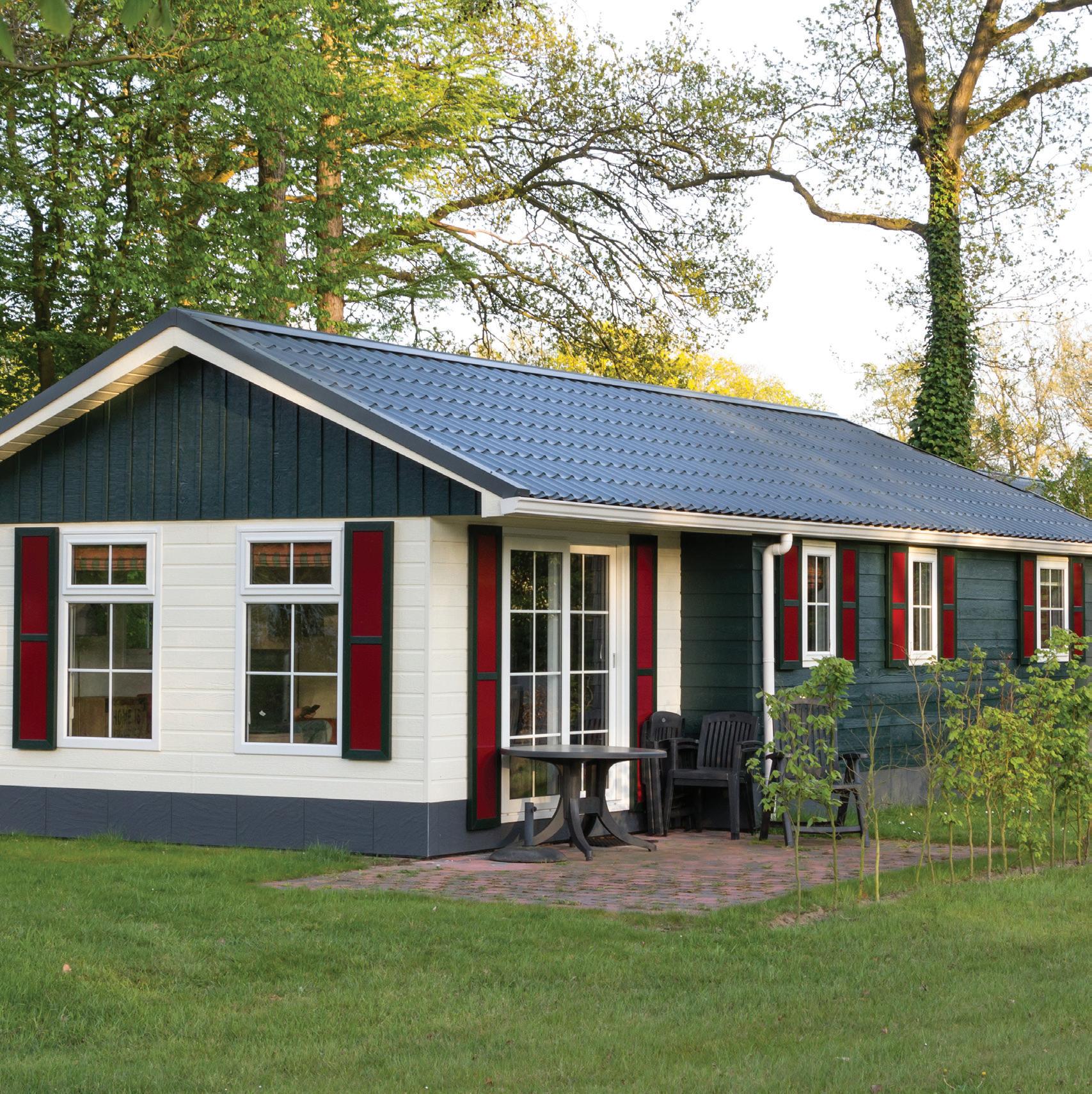
News and educational articles to help you run your business in the manufactured home industry.
Sponsored by:
IN THIS ISSUE: The Housing Revival
According to Freedonia Group Analysts, Demand for Modular Housing is Forecast to Rise 5.2% Annually
2020 Development Trends for Manufactured Home Communities ... and much more!

2020 | Quarter 3
Frank Rolfe
By Brian S.
Table of Contents Bad Times are When Fortunes are Made . . . . . . . . . . . . . . . . . . . . . . . . . . . . . . . 3
The Housing Revival . . . . . . . . . . . . . . . . . . . . . . . . . . . . . . . . . . . . . . . . . . . 4
Wesbury and
Texas Attorney General Ken Paxton Says Local Governments Can’t Stop or Delay Evictions . . . . . . . . . . . . . . . . . . . . . . . . . . . . . . . . . . . . . 5 By Juan Pablo Garnham HUD Issues New Guidance on Assistance Animals . . . . . . . . . . . . . . . . . . . . . . . . . 7 By
Robinson Manufactured Housing Share vs Site Built on the Rise Across The U .S . . . . . . . . . . . . . . . 8
Nelms Clayton® Releases New Website Tool to Help Home Buyers Across the Country “Find Land” 10 Your Winter Home Maintenance Checklist… It’s Not Too Late . . . . . . . . . . . . . . . . . 12 By Michigan Manufactured Housing Association (MMHA) According to Freedonia Group Analysts, Demand for Modular Housing is Forecast to Rise 5 2% Annually 14 By Matt Zielenski 2020 Development Trends for Manufactured Home Communities 15 By Donald Westphal Fannie Mae and Freddie Mac Have Learned Nothing from Their Subprime Debacle 17
Weiss
By
Robert Stein
Rick
By Brad
By Mark
Bad Times are When Fortunes are Made
Industrialist Andrew Carnegie once said, “problems are only opportunities in work clothes”. And J. Paul Getty, the nation’s richest person during the 1950s and 1960s, held the belief that depressions were a great time to make acquisitions and to refine business operations – he, in fact, was only happy when times were bad. Throughout American history, most fortunes were built upon the bedrock of times of economic collapse, when values were lower, distractions few, and the fundamentals of business were easier to enact.
Good economic times make buying mobile home parks harder
Perhaps the most difficult time in American history to buy mobile home parks was the period from around 2002 to 2006. Cap rates were lower than interest rates in many cases, and lumbering giants like ARC bid deals into the stratosphere on flawed economics and diligence (ARC later collapsed). The nation was locked into a faulty mindset that “a rising tide raises all ships” and buyers felt that there would never be a reckoning with values advancing far faster than rents and income would justify. During this period sensible buyers were aghast at most offerings as well as the complete lack of common sense their fellow buyers were demonstrating. The lending mindset of zero down and no income documentation didn’t help much either.

Depressions create opportunity
That same tide of economic prosperity at some point recedes. And “when the tide goes out you get to see who’s been swimming naked” they say. Economic decline ushers in a new era of buying opportunity. Most Americans invest in a “herd” mentality where they want to follow what everyone else is doing, and this lack of individualism only leads to pointless returns and losses. In bad times, the key is to venture out where others are retreating. As Sam Zell – the largest owner of mobile home parks in the U.S. -- says “when everyone is looking left, look right”. And with the unrealistic environment of “the sky’s the future” punctured, smart buyers can get back to business.
The key is to know what you’re doing
If you want to prepare for making good buys during this window of opportunity you have to know what you’re doing. The only way you can garner the confidence to make investments when everyone in the media is saying that the world is ending is to believe in yourself. And that requires putting in the effort to actually know what is a deal from what is not, as well as what the drivers are to profitability and the pitfalls to avoid or mitigate the risk from. When you know enough to break down any deal into the subcategories of
By Frank Rolfe
infrastructure, density, economics, age of homes and location (the I-D-E-A-L system), then you can make fast and correct decisions.
And to have a financing plan
The other key component to buying during economic recessions is to have a source of financing. Fortunately, the mobile home park industry has benefited from being in the affordable housing sector, which is an “essential” industry and one that most lenders have not retreated from. Only CMBS “conduit” lenders have scaled back at this point. That leaves seller financing, bank financing, and Fannie Mae/Freddie Mac “agency” debt as the three key options. And all are still in business and making loans. Better yet, of these three options, two are non-recourse.
Look no further than Sam Zell
Sam Zell has been called the “grave dancer” due to his knack in buying aggressively in recessions, riding the assets up as the economy rebounds. Zell is also the largest owner of mobile home parks in the U.S. with over 160,000 lots in his ELS portfolio. We also share in that philosophy, having been one of America’s most aggressive buyers of mobile home parks during the period following the 2007 Great Recession. We believe that there is historical precedent in the successful business strategy of buying during bad times and in industries that are not on the public’s radar screen.
Conclusion
If you think that the Covid-19 America is one of continual economic decline, then that might be the perfect opportunity to consider mobile home park investing. It’s a contrarian investment that offers high rates of return with a product that’s virtually recession-proof.
Frank Rolfe has been a manufactured home community owner for almost two decades, and currently ranks as part of the 5th largest community owner in the United States, with more than 23,000 lots in 28 states in the Great Plains and Midwest. His books and courses on community acquisitions and management are the top-selling ones in the industry. To learn more about Frank’s views on the manufactured home community industry visit

- 3 -
The Housing Revival

The US economy got crushed in the second quarter, with the worst decline in real GDP for any quarter since the Great Depression. However, the long road to recovery has started and, for now, we’re penciling in real GDP growth at a 20% annual rate for the third quarter. Of all the parts of the US economy that have weathered the COVID-19 storm, none has been as resilient as the housing market.
Homebuilders started homes at a nearly 1.6 million annual rate in December, January, and February, before the Coronavirus and government-mandated shutdowns wreaked havoc. Those were the best three months since 2006 and showed that residential construction had finally fully recovered from the housing implosion that was a center point of the last recession.
Then, during the shutdowns, homebuilding plummeted: housing starts bottomed at a 934,000 annual pace in April, before gaining in May, June and July, hitting an almost 1.5 million pace last month.
We have been saying for the past several years that the fundamentals of the housing market suggest an underlying norm of 1.5 million housing starts per year. This is based on a combination of population growth (more people mean more housing) and scrappage (homes don’t last forever, either because of voluntary knockdowns, fires, floods, hurricanes. tornadoes,...etc.).
However, in the ten years ending in February (March 2010 through February 2020) builders had only started 1.011 million units per year. Part of this made sense: home builders started too many homes during the housing bubble and the only way to work off that excess inventory was to build fewer homes than normal. But, in our view, the inventory correction went too far. In the 20 years through February (March 2000 through February 2020), housing starts only averaged 1.265 million. Too low.
All of this suggests to us that home builders still need to make up for lost time, until the long-term average is closer to 1.5 million per year, which could mean reaching, and then averaging, a pace of something like 1.8 million starts for the next several years.
By Brian S Wesbury and Robert Stein
But it’s not only home building that’s recovered so quickly; home sales have revived, as well. Existing homes were sold at a 5.76 million annual place in February, the fastest pace since the housing bubble burst. Then sales plummeted in March, April, and May, bottoming at an annualized pace of 3.91 million, the slowest since 2010. Since May, however, sales have soared, hitting a 5.86 million annualized pace in July, even beating where we were in February.
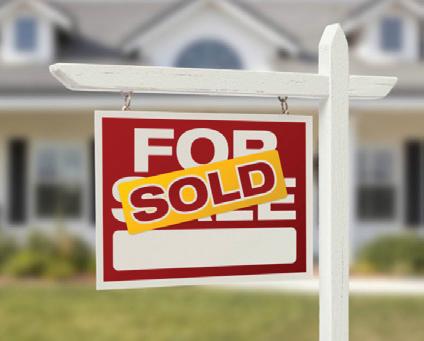
Part of the recent gain was likely pent-up home purchases: people who wanted to buy earlier in the year but got temporarily thrown off track by the Coronavirus, massive economic contraction, as well as general uncertainty. But including the drop and the rebound, the average pace of sales in the last five months (March through July) is still slow, suggesting some further gains ahead. Ditto for new home sales, although neither existing nor new home sales will grow every month.
In terms of prices, we expect national average home prices to continue to grow, but with a wide dispersion. Dense cities hit hard by COVID-19, or which have seen social unrest (or both!), especially with the newfound ability to work remotely, are going to be relative losers; other metro areas are going to experience faster gains.
Yes, a Biden win in November could end up expanding the state and local tax deduction, helping some beleaguered cities. But that election outcome is not assured. The enlarged standard deduction would still mean fewer people itemize, and the Biden campaign wants to limit the “value” of itemized deductions to 28% (instead of a proposed top tax rate of 39.6%).
Bottom line: housing is going to be a significant tailwind for the US economy overall, but not everywhere.
BRIAN WESBURY
800 621 1675
https://www.ftportfolios.com/
Brian Wesbury is Chief Economist at First Trust Advisors L.P., a financial services firm based in Wheaton, Illinois.


ROBERT STEIN
800 621 1675
https://www.ftportfolios.com/
Robert Stein is Deputy Chief Economist at First Trust Advisors L.P. a financial services firm based in Wheaton, Illinois.
This report was prepared by First Trust Advisors L. P., and reflects the current opinion of the authors. It is based upon sources and data believed to be accurate and reliable. Opinions and forward looking statements expressed are subject to change without notice. This information does not constitute a solicitation or an offer to buy or sell any security.
- 4 -
Texas Attorney General Ken Paxton Says Local Governments Can’t Stop or Delay Evictions
By Juan Pablo Garnham
Texas Attorney General Ken Paxton advised Friday that local Texas governments’ attempts to delay evictions for renters grappling with the COVID-19 recession amounted to rewriting state law — something they can’t do, he said in nonbinding legal guidance.

“While local officials do possess certain emergency powers ... statewide eviction procedures far exceed the requirement that those powers be exercised ‘on an appropriate local scale,’” Paxton said in a letter. “Government Code does not authorize local governmental entities operating under a declared disaster to independently rewrite state law as it applies to their jurisdiction to prohibit, delay, or restrict the issuance of a notice to vacate.”
Paxton’s letter, issued in response to a question from Republican state Sen. Brandon Creighton of Conroe, seems to chide local officials like Austin Mayor Steve Adler, who last month extended the eviction moratorium in the city until Sept. 30. Travis County Judge Sam Biscoe extended his ban until the same date. In other counties, like Harris and Dallas, some justices of the peace have decided to not hear evictions. It is unclear if Paxton’s opinion will influence those judges.
Adler said in a statement that his orders were lawful and “do not amend statewide eviction procedures,” but rather aim to “reduce person-to-person contact to slow the spread of COVID-19.”
Hector Nieto, a spokesperson for Travis County, said officials there are reviewing the opinion. Paxton’s opinion could have weight if someone were to sue a local government over its eviction moratorium.
“I can’t say I’m shocked that the state attorney general would side with landlords. Nothing he has done to date shows us that we could expect something different,” said Sandy Rollins, executive director of the housing advocacy group Texas Tenants Union. “A lot of tenants are facing eviction in Texas by zero fault of their own and putting protections that are normal in almost every other state should be allowed in this pandemic.”
According to CityLab, 39% of renters in Texas were not certain they could pay their rent in August, but most eviction moratoriums enacted during the pandemic’s initial blow to the economy have expired. That includes moratoriums at national, state, county, and city levels. The Texas Supreme Court lifted its statewide moratorium in mid-May. A provision included in the federal Coronavirus Aid, Relief and Economic Security Act, which delayed evictions for tenants of federally backed housing, expired in late July.
“We think that it is really important that there is a consistent process, and we think that this opinion supports our thoughts the local ordinances were beyond city authority,” said David Mintz, vice president of government affairs for the Texas Apartment Association. “As we’ve done throughout, we will continue to work with our members so that they do as much as they can to avoid evictions, and we still think that the biggest need is rental assistance to help people that need it.”
Disclosure: Steve Adler, a former Texas Tribune board chairman, has been a financial supporter of the Tribune, a nonprofit, nonpartisan news organization that is funded in part by donations from members, foundations and corporate sponsors. Financial supporters play no role in the Tribune’s journalism. Find a complete list of them here.
Juan Pablo Garnham reports on urban affairs for The Texas Tribune, focusing on the main challenges of the state’s largest metro areas — Houston, Austin, San Antonio, El Paso and DallasFort Worth, where he is based. He previously worked as senior producer for the podcast In The Thick, editor of CityLab Latino and city hall reporter for El Diario in New York. He has also taught at the Craig Newmark Graduate School of Journalism at CUNY. He is from Santiago, Chile, and the Texas flag constantly reminds him of his home country.
This article was first published at https://www.texastribune. org/2020/08/07/texas-evictions-coronavirus-ken-paxton/ by The Texas Tribune.

- 5 -

www.sunstonerea.com
$1 ,
SALES 49,432 SI T E S $1,084,995,182 S ALES VOLUME 279 C OMMUNITIES CHICAGO DALLAS SALT LAKE CITY HOUSTON NASHVILLE SUNSTONE REA OFFICE LOCATIONS
SUNSTONE IS PLEASED TO ANNOUNCE:
000 , 000 , 000 + IN
HUD Issues New Guidance on Assistance Animals By
 Rick Robinson
Rick Robinson
Amajor challenge facing owners and operators of manufactured home communities involves reasonable accommodations for service and assistance animals under the Fair Housing Act. Sixty percent of the Fair Housing Act complaints being investigated by HUD are related to animal claims. For years, industry leaders have been asking HUD to update its rules on this topic. Recently it did so.
On January 28, 2020, HUD issued a press release announcing the new rules. As stated therein, “This new Assistance Animal Notice will help housing providers in this process by offering a step-by-step set of best practices for complying with the Act when assessing accommodation requests involving animals and information that a person may need to provide about his or her disability-related need for the requested accommodation, including supporting information from a health care professional.”
HUD said further it “is providing this guidance to help housing providers distinguish between a person with a non-obvious disability who has a legitimate need for an assistance animal and a person without a disability who simply wants to have a pet or avoid the costs and limitations imposed by housing providers’ pet policies, such as pet fees or deposits.”
The guidance provides best practices for complying with the Fair Housing Act and covers the determining the resident’s, the type of documentation the resident should provide (including, who should provide that information), what types of animals that should be considered for reasonable accommodations and some general considerations.
Click here to download Assessing a Person’s Request to Have an Animal as a Reasonable Accommodation Under the Fair Housing Act.
This guidance from HUD is the most comprehensive instructions ever issued on the reasonable accommodations for service and emotional assistance animals and the instructions contained therein should be incorporated into every community’s Fair Housing policies and procedures.
This guidance follows a November action whereby HUD officials asked the Federal Trade Commission to investigate on-line companies providing certificates declaring a pet as an emotional assistance animal. Click here to read more about the FTC case.
Rick Robinson, Executive Vice President for Industry Relations

Well-known industry professional Rick Robinson has joined ManufacturedHomes.com to become its Executive Vice President of Industry Relations. The former General Counsel/Senior Vice President of State and Local Affairs for the Manufactured Housing Institute (MHI) works to bring a new level of consumer technology to those buying homes and residing in communities.

- 7 -
Manufactured Housing Share vs Site Built on the Rise Across The U.S.
By Brad Nelms
According to the U.S. Census Bureau, there are currently 22 million Americans living in 6.8 million manufactured homes across the U.S. After years of decline starting in the late 1990’s, manufactured housing has been rising in popularity over the last few years.
The manufactured home resurgence compared to new sitebuilt homes in the five year period from 2014 to 2019 is continuing to uptick across the United States, according to data research analysis by Construction Coverage from the U.S.Census Bureau’s Manufactured Housing Survey.

The share of new manufactured homes compared to all new single-family homes was 7.8 percent in 2006. As of 2019, about 10% of new single-family homes (including manufactured homes) are categorized as manufactured homes.
One of the biggest advantages of manufactured homes is the price. The cost advantage is profound. The average sales price of a new site-built home (excluding land) in 2019 was $297,747 – about 6 times more expensive than a single-section home ($52,400) and 3 times as expensive as a double-section manufactured home ($99,500).
While the average site-built home is larger than the average manufactured home, the latter is by far, the most cost-effective option on a per-square-foot basis. The price per square foot for a manufactured home is about $50, compared to $114 for a site-built home (excluding land), an astounding differential when considering that a manufactured home will be equal, and often superior, to a site-built home in every respect, including quality of construction, materials, amenities, durability energy efficiency, fire and wind safety and customization options to meet home buyer’s specific needs and wants.
Historically, Manufactured Homes Have Been More Popular In The South And West
The lion’s share of manufactured homes are predominately in Southern and Western U.S. states where one-third of all homes in 111 counties are manufactured homes. Another example; the share of manufactured homes in New Mexico, South Carolina, Mississippi, and West Virginia are more than twice the national average. On the other hand, less than 2 percent of homes in the northeast states like Rhode Island, Massachusetts, New Jersey, and Connecticut are manufactured homes.
Here are the statistics for the entire United States:
• 5-year change in new manufactured homes: 47.1%
• 5-year change in new single-family site-built homes: 34.6%
• New single-family homes in 2019: 94,615 manufactured/862,100 site-built.
• Share of existing single-family homes that are manufactured: 7.5%
Surprising for many, is the fact that the manufactured home share of single-family homes, compared to site-built, increased in 41 U.S. states over the preceding five years (2014 to 2019). (Note: Hawaii, Rhode Island, Alaska and District of Columbia were excluded due to insufficient data on manufactured housing).
Top 5 States Where Manufactured Home Share Increased 130% plus Compared To Site-Built
According to the aforementioned U.S. Census Bureau’s Manufactured Housing Survey for each state, the five-year
- 8 -
Manufactured Housing Share vs Site Built on the Rise Across The U.S. Cont.
change in new manufactured homes was calculated as the percentage change in new manufactured home shipments comparing 2019 to 2014. Statistics on new single-family site-built homes are from the U.S. Census Bureau’s Building Permit Survey. Similarly, the five-year change in new singlefamily site-built homes was calculated also comparing 2019 to 2014. Following are the five states with a 130% plus share increase in manufactured homes:
4. WISCONSIN
• 5-year change in new manufactured homes: 152.7%
• 5-year change in new single-family site-built homes: 31.6%
• New single-family homes in 2019: 657 manufactured/11,298 site-built.
• 5-year change in new manufactured homes: 301%
• 5-year change in new single-family site-built homes: 47.3%
• New single-family homes in 2019: 810 manufactured/13,088 site-built.
• Share of existing single-family homes that are manufactured: 5.5%
2. INDIANA
• 5-year change in new manufactured homes: 164.9%
• 5-year change in new single-family site-built homes: 34.3%
• New single-family homes in 2019: 2,180 manufactured/16,308 site-built
• Share of existing single-family homes that are manufactured: 5.5%
• Share of existing single-family homes that are manufactured: 3.8%
5. GEORGIA
• 5-year change in new manufactured homes: 138.7%
• 5-year change in new single-family site-built homes: 56.1%
• New single-family homes in 2019: 3,649 manufactured/42,939 site-built.
• Share of existing single-family homes that are manufactured: 9.9%
The following six states posted percentage changes in new manufactured home shipments in excess of 100%.
6. Nebraska 113.9%
7. New Jersey 109.9%
8. North Carolina 108.8%
9. Minnesota 108.1%
• 5-year change in new manufactured homes: 162.2%
• 5-year change in new single-family site-built homes: 4.4%
• New single-family homes in 2019: 860 manufactured/5,089 site-built
• Share of existing single-family homes that are manufactured: 4.7%
10. Florida 106.9%
11. Arizona 105.5%
As the U.S. enters a recession in the wake of the coronavirus outbreak, the demand for both site-built and manufactured housing is likely to undergo even more dramatic changes in the near future.
- 9 -
1. NEVADA
3. KANSAS
Clayton® Releases New Website Tool to Help Home Buyers Across the Country “Find Land”

“Find Land” helps future home buyers find the perfect property for off-site built homes
Clayton®, a national home builder of site-built and off-site built homes, is excited to launch Find Land, a search engine tool to help home buyers find property listed for sale where off-site built homes could potentially be placed.
The new, digital experience taps into the Multiple Listing Service (MLS) and allows future buyers to search by zip code for available lots on a regional map, while also displaying additional information, such as if a property is zoned for manufactured off-site built homes.* Users can filter land for sale by preferred distance from the chosen zip code and price range, while discovering photos, additional property details and real estate agent contact information.
As the need for affordable housing becomes more crucial, Clayton is committed to continuously providing innovative housing solutions for its customers. More and more offsite built homes are being permanently attached to land with features like garages and porches, so Clayton naturally integrated the step to find land into its digital home shopping experience.
“In a time when our customers may understandably prefer to shop digitally as they search for the perfect new home and property, innovative website tools like Find Land help

make this possible,” said Pat Egan, VP of Clayton Corporate Marketing. “Clayton remains committed to improving our customer experience by transforming the journey to find the perfect home for families who are seeking an affordable, quality housing solution. We know finding the ideal location to place a forever home is just as important as finding the dream floor plan.”
Find Land assists many home buyers, including those purchasing CrossMod™ homes**, the newest class of manufactured housing, which incorporates features that are more similar to traditional site-built homes. These beautiful homes are designed to be permanently affixed to land and have the potential to increase in value over time. Clayton’s CrossMod home features include a permanent foundation, enhanced cabinets, drywall interiors, energy efficient standards and features, an elevated roof pitch and a covered porch, garage or carport.
Find Land assists future home buyers by conveniently integrating the property buying process and the off-site built home shopping experience. Discover more about the process, browse homes and Find Land to start the journey of making a dream home a reality.
*Properties without this label may still be zoned for off-site built homes. Work with a real estate agent to learn more
**CrossMod™ is a trademark of the Manufactured Housing Institute.
About Clayton Founded in 1956, Clayton is committed to opening doors to a better life and building happyness® through homeownership. As a diverse builder committed to quality and durability, Clayton offers traditional site-built homes and off-site built housing – including modular homes, manufactured homes, CrossMod™ homes, tiny homes, college dormitories, military barracks and apartments. All Clayton Built® homes are proudly designed, engineered and assembled in America. In 2019, Clayton built 51,964 homes across the country. Clayton is a Berkshire Hathaway company. For more information, visit claytonhomes.com
- 10 -

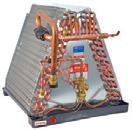
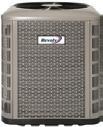

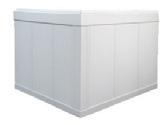


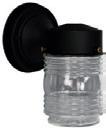

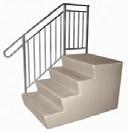


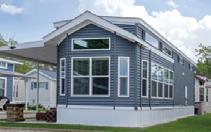






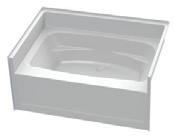
www.stylecrestinc.com | 800.945.4440 HVAC | Foundation Covers | Doors & Windows | Steps & Rails | Set Up Materials | Vinyl Siding | Plumbing | Electrical
Century
Still Going Strong! For 50 years, Style Crest® has demonstrated commitment to the manufactured housing industry with an extensive product offering and a dedicated service platform that customers count on to support the success of their businesses.
Half a
&
Your Winter Home Maintenance Checklist… It’s Not Too Late
By Michigan Manufactured Housing Association (MMHA)


(a task that should be done about once a year). Most water heaters are also big energy wasters. The thermostats in many water heaters are set too high which can be wasteful and even dangerous. Make sure your thermostat is set no higher than 120 degrees.
Gutters: When we have one of those “warmer than average” days and you want to venture up a ladder, check for any debris or leaves that may have made their way into your gutters and make sure downspouts are clear to allow for that melting snow to drain away from your home in early spring.
Detectors: Winter brings an increased risk of home fires and carbon monoxide leaks. Make sure you and your family are protected by replacing the batteries in your smoke detectors and carbon monoxide detectors. Or replace smoke detectors that are over 10 years old with a combination model.
In the winter, your home should be a fortress. No precious heat escaping and no winter weather making its way in. Make use of that extra “indoor” time and follow these tips from the Michigan Manufactured Housing Association to complete your winter home maintenance checklist and make sure your home is running as energy efficiently as possible.
Windows: Check around windows to make sure they are well sealed. On a windy day, put your hand around the frame and feel for airflow. Use caulk to seal around the frame or use a plastic window insulation kit to cover an entire window. Heavy curtains will also help keep more heat from escaping from windows. It may sound simple, but make sure all the windows in your home are closed and latched. Top sashes tend to slide downward over time if they’re not locked, letting cold air into your home.

Doors: Check for cracked or worn weather stripping and replace as needed. When you touch the door, you should not be able to feel the exterior’s cold on the inside surface. If so, then your door may not have adequate insulation and you should consider upgrading the door with a replacement that is more energy efficient.
Heating system: Change your furnace filter regularly, and have your furnace inspected by a professional to make sure it is running efficiently, and your ducts are sealed properly. A programmable thermostat is a must, or, even better, an Internet-connected thermostat to program based on your schedule and allow you to turn the thermostat up or down from your smartphone.
Water heater: Now is a good time to drain your water heater
A great extra step is a professional energy audit. Contact your local energy provider to see if this is available in your area.
These tips will not only help keep your home cozier and more efficient in the winter, it will also help in those warmer months ahead and we promise, they will be here before you know it.
Sources: Quick and Dirty Tips, EnergyStar, The Globe
- 12 -

According to Freedonia Group Analysts, Demand for Modular Housing is Forecast to Rise 5.2% Annually
According to Freedonia Group analysts, demand for modular housing (also known as system-built housing) is forecast to rise 5.2% annually to 23,700 units in 2024.
Advances will be boosted by such factors as:
• Homeowner interest in modular housing due to its perception as a high-end alternative to manufactured housing:
• Modular homes are built to local building codes –not the HUD Code – and thus more frequently offer modern features, such as enhanced energy efficiency.
• Modular homes are installed on foundations or slabs and are not designed to be moved after installation.
• The tendency for modular houses to be larger than manufactured units and more closely resemble sitebuilt residences
• Most modular units cost less than site-built homes
• Increasing use of small modular homes – accessory dwelling units (ADUs) or “tiny homes” – that can be used to alleviate local housing shortages or provide multigenerational living options
• Rising use of modular units in multifamily housing –units can be installed on each, or stacked, to create apartment complexes with similar designs that facilitate maintenance and the connection of utilities
By Matt Zielenski
Shipments of modular homes are anticipated to climb 5.3% per year to 23,300 units in 2024.
Gains will be boosted by increasing domestic demand for modular housing. Tiny home production will see the fastest growth – albeit from a low base – due to their small size, which speeds up the production of these units.
Learn more about all types of Prefabricated Housing including the short-term negative effects of the COVID-19 pandemic in the new study

Matt Zielenski is a Senior Analyst at The Freedonia Group, where he covers trends in the use of building materials and related construction products in the US market..
About The Freedonia Group – The Freedonia Group, a division of MarketResearch.com, is a leading international industrial research company publishing more than 100 studies annually. Since 1985 we have provided research to customers ranging in size from global conglomerates to oneperson consulting firms. More than 90% of the industrial companies in the Fortune 500 use Freedonia Group research to help with their strategic planning. Each study includes product and market analyses and forecasts, in-depth discussions of important industry trends, and market share information. Studies can be purchased at https://www.freedoniagroup. com/ and are also available on https://www.marketresearch.com/ and https://www.profound.com/Home.aspx?ReturnUrl=%2f

- 14 -
2020 Development Trends for Manufactured Home Communities
By Donald Westphal
generate minimal opposition. If not, it is important to bring it up to respectability before seeking approval to expand. The expansion also can provide an opportunity for existing residents to upgrade to a new home in the expansion area, allowing for the removal of less attractive older homes. New home sales in the expanded community provide an additional profit center for the owner. Additional utility services may be available from the local supplier or attainable through the expansion of the existing on-site facility. The addition of new sites to the existing community may not require a significant increase in overhead, another benefit to expansion. Care should be exercised to the disruption to existing residents caused by construction activities and some up-grade in the community amenities is advisable to minimize residence concerns.
A Planner’s Perspective
Owners and operators of manufactured home communities are seeing interesting developments in three areas of the business.
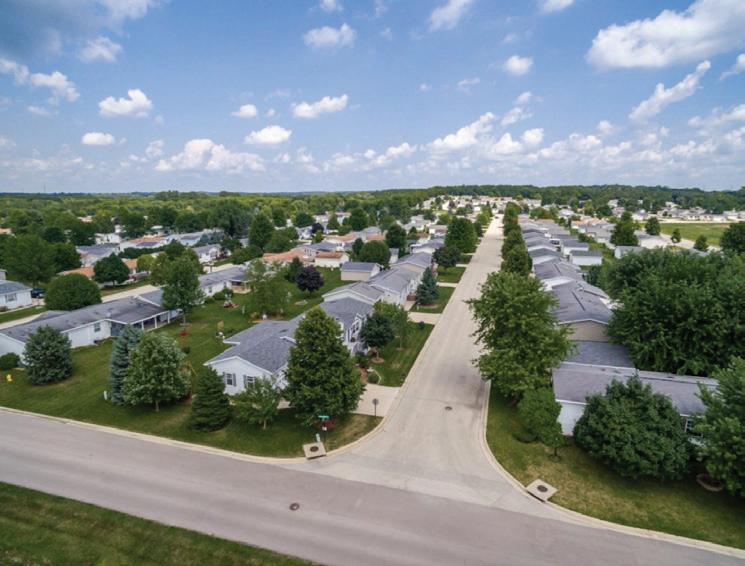

• New Greenfield Projects
• Community Expansions
• Older Community Upgrades
Greenfield Projects
The need for new communities is great in most parts of the country. After years of vacancies in communities, most desirable existing communities are at or near capacity, resulting in an increasing demand for new projects. Unfortunately, zoning new sites is difficult. Sewer and water availability in desirable locations where zoning is attainable is rare. Many available zoned sites are in undesirable or difficult locations. And public opposition to new communities continues to come from the “trailer park” perception.
Construction costs are rising, but so is the value of the finished project. As a result, it is important to take advantage of unique ways development costs can be minimized by using knowledgeable manufactured housing community planners and engineers.
Community Expansions
It is often easier to expand an existing community than to start anew. Zoning in many cases is less difficult since it is an expansion of an existing use. And hopefully, the existing community is well managed and cared for and will
Community Upgrades
Upgrading an existing community is a win-win for the owner, the residents, and the industry. The community already is properly zoned and in a great location. Making the community more attractive and livable should be welcomed by residents and neighbors alike. On the negative side, some communities have rezoned undesirable properties making the addition of newer homes difficult. However, many of our more progressive state associations have tackled this matter and made the practice unlawful. Often municipalities require reconfiguration of home-sites to conform to the existing regulations regarding setbacks and lot sizes. Fortunately, many states allow for lot reconfigurations to reflect the rules that were in effect
- 15 -
Photo courtesy of Zeman Homes.
2020 Development Trends for Manufactured Home Communities Cont.

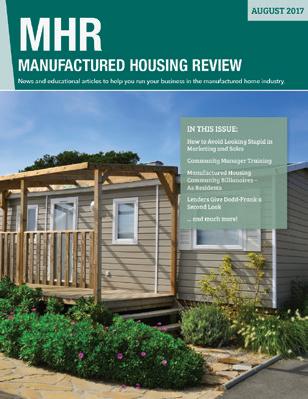
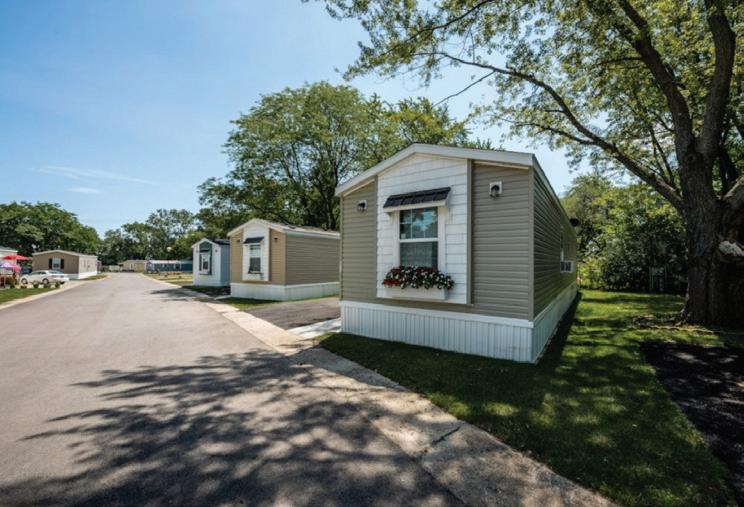
appearance, and landscaping — it can stimulate residents to upgrade their home and home-site appearance.
Revisions to the community’s “Guidelines for Living” in a reasonable time frame will assist in that effort.
All three of the options discussed, if properly done, will give the industry a much-needed image boost and ready the market for expansion.
Donald C. Westphal, Associates, LLC, winner of seven Community of the Year Awards, has a 50-year history of planning great Manufactured Communities and is still enthusiastically serving the industry. Learn more at www.dcwestphal. com.


when the community was originally constructed. Michigan and Indiana are two states with that advantage. Many times, residents become concerned about their future. However, if the owner has the foresight to get its image in order first — entrance upgrades, street improvements, refreshed structure
Originally published in the MHInsider. ©2020 MHVillage. Used with Permission
- 16 -
SUBSCRIBE! Manufactured Housing Review Magazine www .manufacturedhousingreview .com staff@manufacturedhousingreview .com
Photo courtesy of Zeman Homes.
Fannie Mae and Freddie Mac Have Learned Nothing from Their Subprime Debacle
For the vast majority of lower and moderate-income Americans seeking to enter the housing market via the most direct and affordable means – i.e., through the purchase of a mainstream, inherently HUD Code manufactured home – the Duty to Serve Underserved Markets (DTS) mandate, enacted by Congress twelve year ago as part of the Housing and Economic Recovery Act of 2008 (HERA), has been a cruel joke. The ineffectual and arguably deceitful so-called “implementation” of DTS by Fannie Mae, Freddie Mac and their erstwhile federal regulator, the Federal Housing Finance Agency (FHFA), has left the overwhelming majority of actual and potential manufactured homebuyers completely “unserved.” As a result, they have been – and continue to be -- at the mercy of a small number of higher-interest rate lenders, backed by Berkshire Hathaway Corp. and other “big money” sources, that do need or want securitization or secondary market support from Fannie Mae and Freddie Mac. Meanwhile, other independent lenders, due to the lack of DTS support, have stayed out of the HUD Code consumer lending market. This, combined with the virtual destruction of the Federal Housing Administration’s Title I manufactured housing program as a result of the Government National Mortgage Association’s punitive “10-10” rule, has resulted in a mainstream manufactured housing financing market that is not fully competitive and thus sustains the higher interest rates charged by the lending affiliates of the industry’s largest conglomerates, all to the detriment of affordable housing consumers and the broader industry.
The sad reality, therefore, for both the industry and its consumers, is that the alleged “implementation” of DTS for the manufactured housing market – as planned and carried out by Fannie, Freddie and FHFA – has been, and continues to be after more than a decade, a dismal failure.
That evidence not only demonstrates that DTS, in its current iteration, has failed, but that it was – and has been – essentially “designed” to fail by Fannie, Freddie and their FHFA “regulators.” As a result, both Fannie and Freddie, and FHFA, in order to comply with the DTS law, as enacted by Congress, need to go back to the “drawing board” and fundamentally re-think, re-envision and revamp their approach to DTS based on the current-day realities of the HUD Code market, and not what Fannie and Freddie would prefer to see emerge in place of the current market and the current homes the industry offers to consumers. Fannie and Freddie, then, rather than continuing their effort to put lipstick on the proverbial “pig” that is their current failed approach to DTS, need to candidly acknowledge their failure and develop DTS implementation programs for mainstream, affordable manufactured housing that is not focused on changing those homes to be “more like”
By Mark Weiss
site-built homes, but is instead designed to “serve the masses” – i.e., each and every qualified potential purchaser -- based on the current market and the industry’s current products. And the fact that this has not happened – after 12 years of supposed DTS “implementation” within the manufactured housing market -- proves that Fannie and Freddie have learned absolutely nothing from their “subprime” debacle and related market meltdown, or are knowingly repeating the same mistake(s) as explained further below.
In this regard, an objective look at the evidence showing the failure of DTS with respect to the HUD Code market over the past decade-plus is quite revealing, particularly in light of efforts by Fannie, Freddie and their supporters/apologists within the industry, to downplay or ignore that data and information.
For example, according to recently published reports, Fannie Mae financed a grand total of six of the Manufactured Housing Institute’s highly-touted “new class” of more costly “hybrid” manufactured homes in 2019, of which, exactly two counted for DTS credit. (See, Fannie Mae 2019 DTS Compliance Report, 2019 Manufactured Housing Loan Product, p.5: “In 2019 we [Fannie Mae] purchased six MH Advantage Loans, of which two were eligible for Duty to Serve credit.”) Freddie Mac, for its part, apparently financed none of the supposed “new class” of manufactured homes in 2019.
Meanwhile, together, both Fannie and Freddie provided DTS support for precisely zero manufactured homes financed through personal property (or “chattel”) loans in 2019, continuing their sterling record of doing exactly nothing under DTS for the vast bulk (approximately 80%) of manufactured homebuyers for the umpteenth year in a row, and for the entire twelve years that have passed since Congress’ enactment of the DTS mandate.
Nevertheless, both Fannie and Freddie will tell you -- and as FHFA unbelievably certified to Congress a few months ago -- both Enterprises are supposedly acting “in full compliance” with DTS vis-à-vis manufactured housing and consumer purchase loans for mainstream HUD Code manufactured housing. And if you believe that, there’s a bridge for sale in New York City.
And, beyond that? Well, there’s actually more from the world of damning statistics to round out the picture. According to FHFA’s own “dashboard” of DTS data, Fannie Mae and Freddie Mac, together, served a grand total of 30% of the manufactured housing real estate borrowers who were making an initial new home purchase (i.e., not re-financing
- 17 -
borrowers) in 2017. For 2018 and 2019, the comparable figure is 34% each year. Given the fact that the real estate segment of the manufactured housing market, according to U.S. Census Bureau data, constituted approximately 17% of the overall manufactured housing market in 2017 and 2018, and 19% in 2019, that means Fannie and Freddie, for new home purchasers under DTS, have supported no more than 5.0 to 6.4% of the total HUD Code market comprised of new home purchasers.
Put differently, this means that more than a decade after Congress instructed the GSEs to finally begin serving the affordable manufactured housing market in a marketsignificant way – following decades of refusal, evasion and malign neglect – Fannie and Freddie (with the blessing and consent of FHFA) have left 94 to 95% of the total manufactured housing finance market for new homes completely unserved – with no real change in sight anytime soon. You wouldn’t know that, though, from the self-congratulatory hot air and chest-thumping emanating from Fannie, Freddie and their supporters/apologists within the industry. Supposedly, then, serving 5 or 6% of the market (at best) and leaving 94 or 95% unserved, qualifies as “compliance” with the law. Try making that kind of argument to your nearest friendly taxing authority – that paying a tiny fraction of your bill is “compliance” – and see how far you get.
And what kind of impact does all this have on the industry and Americans in need of inherently affordable, non-subsidized housing and homeownership? The statistics, again, paint a bleak picture. According to the August 30, 2020 edition of “Housing Market 2020,” the National Association of Realtors (NAR) “report for July [2020] shows national sales growth of single-family [i.e., site-built] homes, townhomes, condominiums and co-ops, lept 24.7% from June’s to a new sales total of 5.86 million homes in July” and “July’s 24.7% leap is on top of June’s big jump of 20.7%....” In sharp contrast to the site-built market, which has apparently shaken off the economic effects of the Covid-19 pandemic and is expanding significantly, manufactured housing production for the last two HUD-reported months of May and June, 2020, were both down from the corresponding months in 2019, with May 2020 down 22% and June down by 2.5%. So, while the sitebuilt housing market is recovering and posting new gains, the HUD Code housing market continues to underperform – particularly in relation to the growing national need for affordable housing and homeownership.
Not surprisingly, viewing all of this from the perspective of the individual manufactured housing consumer, things are just as bad – if not worse – than they are collectively over the entire market. Most significantly, in the absence of DTS support
by Fannie and Freddie for the vast bulk of the manufactured housing market – and particularly the largest segment of the market, served by personal property loans -- manufactured homebuyers, according to a new report published by Freddie Mac (“Manufactured Home Loan Performance (For Originations Between 2009 and 2019”) -- are paying unnecessarily and disproportionately higher interest rates for their home loans. As is stated by the Freddie Mac report: “More than 90% of the [manufactured housing] personal property loans reported in the 2018 HMDA [Home Mortgage Disclosure Act report] are … higher-cost originations.” Worse yet, what is not revealed by this particular statistic, is just how many lower and moderate-income American families have been -- and are being -- totally excluded from homeownership because the cost of purchasing a manufactured home, the nation’s most affordable type of housing, is made much less affordable because of the unavailability of anything other than a high-interest loan to finance its acquisition. Yet, Fannie, Freddie and FHFA, tell Congress with a straight face, and would have Congress believe, that DTS is being properly and lawfully implemented – a flat-out fiction.
Moreover, if you are looking for confirmation of this evidence and the conclusions that MHARR has drawn with respect to the failed “implementation” of DTS, there is no need to look beyond the words of departing FHFA Duty to Serve Manager, Jim Gray, who, in an August 31, 2020 farewell note to DTS stakeholders, candidly acknowledged: “[W]e have not made as much progress [under DTS] as many of us would have liked; so much remains to be done to reach these [DTS] markets.” While this acknowledgment by the de facto head of DTS implementation at FHFA is accurate as far as it goes, it unfortunately misses the most important and significant point. And that is simply that DTS, as it has been “implemented” to date by Fannie and Freddie, is not designed to work within the existing HUD Code market and, as currently constituted, cannot and will not work in that market to reach the “masses” of potential purchasers or, put differently, to provide support for the mainstream HUD Code market on a market-significant basis – as MHARR has asserted and maintained for some time.
What has instead occurred, for anyone willing to acknowledge and confront the facts as they are – not as some would like to portray them – is that the institutional resistance within Fannie Mae and Freddie Mac to serving the vast, overwhelming bulk of the truly affordable, mainstream HUD Code manufactured housing market, remains as strong as ever, notwithstanding DTS. This institutional resistance is manifested not only by Fannie and Freddie’s outright refusal to serve the mainstream HUD Code chattel market in any respect, but also in their parallel effort to divert as much of DTS as possible (within the manufactured housing market) to much higher cost
- 18 -
Fannie Mae and Freddie Mac Have Learned Nothing from Their Subprime Debacle Cont.
Fannie Mae and Freddie Mac Have Learned Nothing from Their Subprime Debacle Cont.
“ChoiceHome” and “MH Advantage” hybrid homes. This is nothing more than a “do-over” of the same hubris and arrogance that led to the subprime crisis and the nearcollapse of Fannie and Freddie, as they sought – together with certain lenders – to put people into overpriced mortgages (and homes) that they simply could not afford. The result, once again, is that the credit-worthy lower and moderateincome Americans who Fannie and Freddie were created to serve, are once again kicked to the side, while both mortgage giants seek and pursue a more “upscale” clientele.
So, as so often happens, Congress has provided the industry and its consumers with a good law – a law that could and should be a game-changer for the entire HUD Code market -- but the Washington, D.C. “swamp” (as with the 2000 reform law), is doing its utmost to twist, distort and negate that law with the tacit acceptance, or even outright enthusiasm, of those supposedly “representing” the industry’s post-production sector (i.e., retailers, communities, finance companies, etc.). This is unacceptable. DTS is not a device for changing the fundamental nature of HUD Code manufactured housing or further degrading competition within the manufactured housing market. It is, rather, a remedy, mandated by statute directing both Fannie Mae and Freddie Mac to finally serve lower and moderate-income manufactured housing consumers in a manner and in numbers that are consistent with their respective Charters and their fundamental mission to promote homeownership among all segments of society.
It has long been said that the first step in solving a problem is to recognize that there is a problem in the first place. In this instance, Fannie Mae and Freddie Mac, despite having already
been through the subprime debacle – promoting excessive loans on over-priced homes to people who clearly could not afford them – are now, through the same type of hubris and arrogance, seeking to avoid DTS support for truly affordable HUD Code homes, while trying, and failing, to push the market toward much higher-priced, non-mainstream, “hybrid homes. Instead, Fannie, Freddie and their regulators at FHFA, should – and must – acknowledge the unavoidable reality that their job under DTS, at least as far as manufactured housing is concerned, is not getting done, and that has to fundamentally change as soon as possible, given the fact that they, together, have already wasted twelve years.
Mark Weiss is the President and CEO of the Manufactured Housing Association for Regulatory Reform (MHARR) in Washington, D.C. He has served in that position since January 2015 and, prior to that, served as MHARR’s Senior Vice President and General Counsel.

MHARR is a Washington, D.C.-based national trade association representing the views and interests of independent producers of federally-regulated manufactured housing.
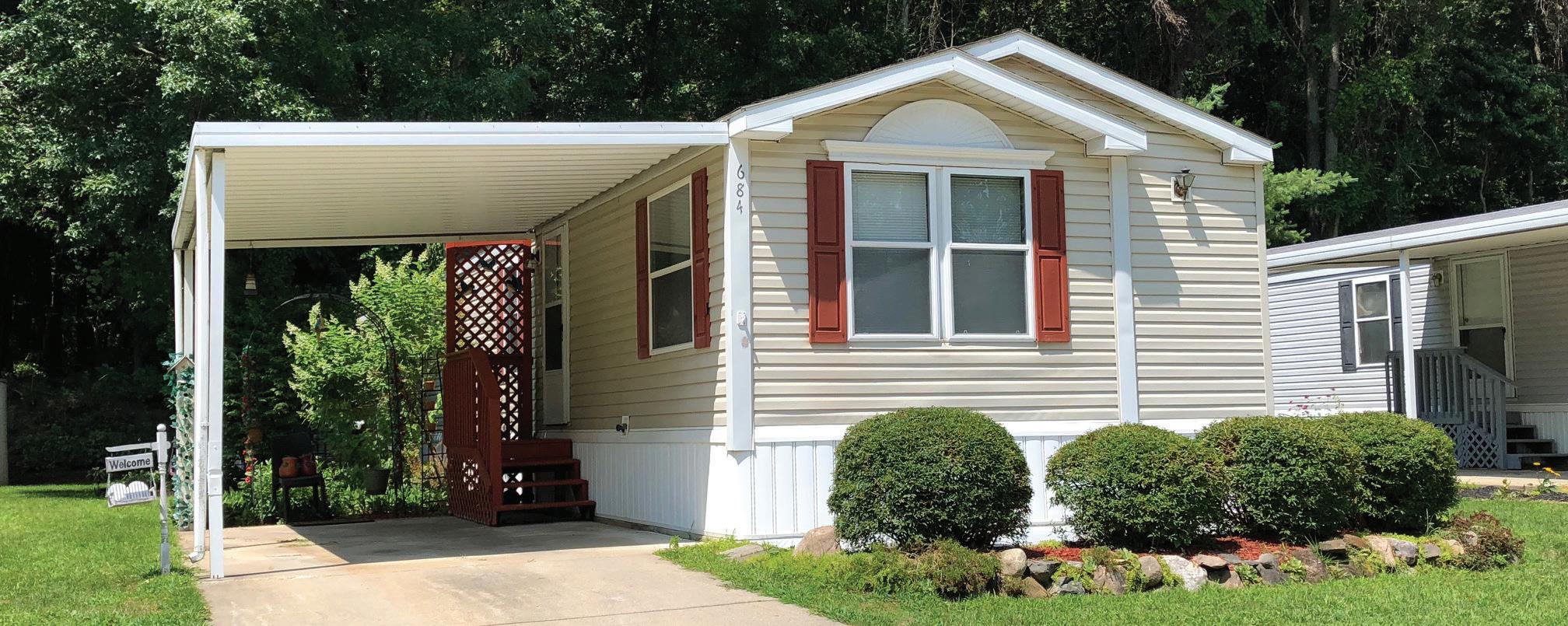
“MHARR-Issues and Perspectives” is available for re-publication in full (i.e., without alteration or substantive modification) without further permission and with proper attribution to MHARR.
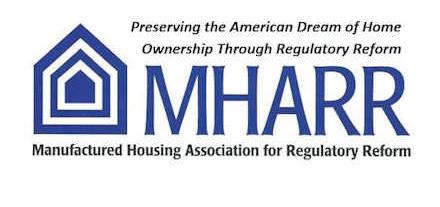
- 19 -



“We make your business STRONGER” Industry Leading Value & Expertise We Offer Special Insurance Programs for Manufactured Homes Kurt Kelley, President MHAO Steve Ross Award Winner www.mobileagency.com Kurt@mobileagency.com 800-458-4320 Retailers Installers Communities Transporters Apartments Developers Investors Self Storage Homeowners
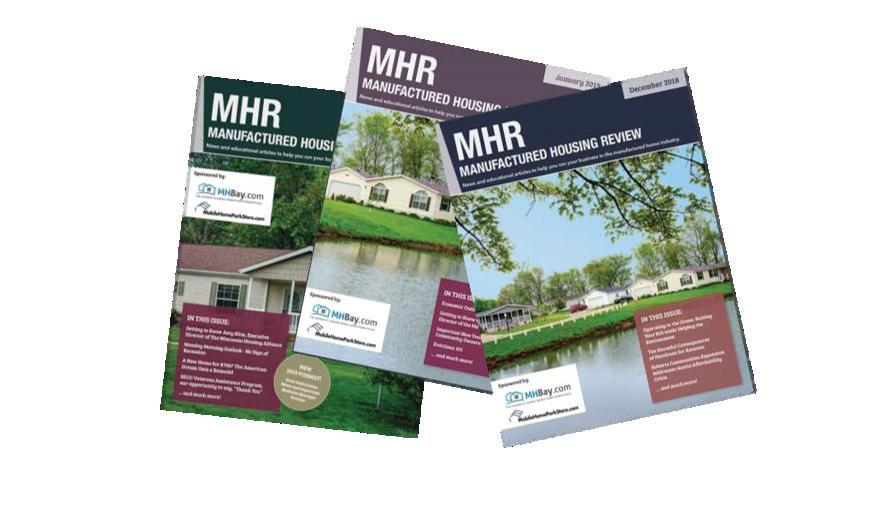
MHR MANUFACTURED HOUSING REVIEW We are an electronically delivered quarterly magazine focused on the Manufactured Housing Industry. From Manufactured Home Community Managers, to Retailers, to Manufacturers, and all those that supply and service them, we supply news and educational articles that help them run their businesses. ManufacturedHousingReview.com Communications regarding any alleged offending, inappropriate, inaccurate or infringing content should be directed immediately to kkelley@manufacturedhousingreview.com along with the communicator’s contact information. Have something to contribute or advertise? Email us at staff@manufacturedhousingreview.com













 Rick Robinson
Rick Robinson












































